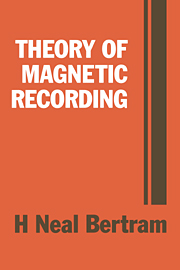Book contents
- Frontmatter
- Contents
- Preface
- 1 Overview
- 2 Review of magnetostatic fields
- 3 Inductive head fields
- 4 Medium magnetic fields
- 5 Playback process: Part 1 – General concepts and single transitions
- 6 Playback process: Part 2 – Multiple transitions
- 7 Magnetoresistive heads
- 8 Record process: Part 1 – Transition models
- 9 Record process: Part 2 – Non-linearities and overwrite
- 10 Medium noise mechanisms: Part 1 – General concepts, modulation noise
- 11 Medium noise mechanisms: Part 2 – Particulate noise
- 12 Medium noise mechanisms: Part 3 – Transition noise
- References and bibliography
- Index
1 - Overview
Published online by Cambridge University Press: 02 February 2010
- Frontmatter
- Contents
- Preface
- 1 Overview
- 2 Review of magnetostatic fields
- 3 Inductive head fields
- 4 Medium magnetic fields
- 5 Playback process: Part 1 – General concepts and single transitions
- 6 Playback process: Part 2 – Multiple transitions
- 7 Magnetoresistive heads
- 8 Record process: Part 1 – Transition models
- 9 Record process: Part 2 – Non-linearities and overwrite
- 10 Medium noise mechanisms: Part 1 – General concepts, modulation noise
- 11 Medium noise mechanisms: Part 2 – Particulate noise
- 12 Medium noise mechanisms: Part 3 – Transition noise
- References and bibliography
- Index
Summary
Magnetic recording is the central technology of information storage. Utilization of hard disk drives as well as flexible tape and disk systems provides, inexpensively and reliably, all features essential to this technology. A data record can be easily written and read with exceedingly fast transfer rates and access times. Information can be permanent or readily overwritten to store new data. Digital recording is the predominant form of magnetic storage, although frequency modulation for video recording and ac bias for analog recording may persist in consumer applications. Data storage is universally digital. Superb areal densities for disk drives and volumetric densities for tape systems are achievable with extremely low error rates. In the last decade there have been extraordinary advances in magnetic recording technology. Current densities and transfer rates for disk systems are typically 60Mbits/in2 and 10Mhz, respectively, but systems with densities of 1–2Gbits/in2 are realizable (Wood, 1990; Howell et al., 1990; Takano, et al., 1991). The ability to coat tape with extremely smooth surfaces has permitted the development of very high density helical scan products (SVHS, 8mm video) (Mallinson, 1990). The digital audio helical scan recorder (DAT) is representative of very high density tape recording with linear densities of greater than 60kbits/in, track densities of 250 tpi, and volumetric densities on the order of 50Gbits/in3 (Ohtake, et al., 1986). High data rate tape recording systems near 150MHz have been developed (Ash, et al., 1990; Coleman, et al., 1984). In general, densities and data rates of magnetic recording systems have been increasing at a rate exceeding a doubling every three years.
- Type
- Chapter
- Information
- Theory of Magnetic Recording , pp. 1 - 16Publisher: Cambridge University PressPrint publication year: 1994



